Everyone at home has a wide variety of flowers on their windowsills. A frequent guest in our " indoor garden"There are Kalanchoe. However, few people know that this tropical flower can bloom. Our article will tell you why Kalanchoe does not bloom and how to deal with it.
When caring for Kalanchoe, it is difficult to imagine that this flower can bloom. After all, the most characteristic species of the plant is an evergreen succulent with fleshy and very succulent leaves, and a flowering Kalanchoe will sound like nonsense to many. But when a flower grows at home, it can be made to bloom.
If you do everything right, this flower will become a worthy decoration for your windowsill. Especially if you are the owner of a variety that has beautiful inflorescences decorative look. Unfortunately, due to a number of reasons, this plant blooms extremely rarely at home.
Answering the question “why doesn’t Kalanchoe bloom?”, experts identify the following possible reasons:
- incorrect lighting. It is known that Kalanchoe comes from tropical countries, so this plant does not like direct sunlight. At the same time, the flower also negatively tolerates shadow. If at home the Kalanchoe is in the shade, then it begins to grow upward (the plant will become very elongated) and after a while it may even die. An excellent place to grow this tropical guest in our latitudes at home would be to place the pot on a windowsill with sunny side, avoiding the sun;
- long daylight hours. For this plant to bloom, it needs to be kept in a dark place for at least 10 hours every day. But it is not always possible to create such conditions at home. Although at home you can create such a darkening without any problems - you just need to put the pot in a closet or cover it with a dark box;
- excess fertilizing. Frequent feeding is also not recommended. This very often leads to no flowering. Kalanchoe does not like very heavy soils and reacts quite negatively to frequent application of mineral fertilizers to the soil;
- lack of peace. When growing this plant, you should know that it requires rest before the flower buds awaken. In this case, the flower can either go to rest on its own or require creation. special conditions for this. Here you need to make a special temperature regime, as well as regulate the length of daylight hours.
Another reason that can lead to a lack of flowering is an incorrectly selected water regime. In order for Kalanchoe to bloom, it is important to properly organize its watering. A negative factor can be either insufficient or excessive watering.
Therefore, if you want the plant to bloom in your home, normalize the flow of moisture into its pot. In addition, in the presence of pests, the plant also loses its ability to flower. If Kalanchoe receives competent and proper care
, and is also watered properly, the plant successfully copes with attacks from various harmful insects. But a lack of moisture can make a flower helpless in the face of this scourge.
If you know what led to the lack of flowering, then you will be able to draw the right conclusions and change the growing conditions of the plant at home in order to finally see the inflorescences. Therefore, the answer to the question “how to make Kalanchoe bloom?” will not do without the next step - you must first find out the root cause of the current situation.
Transplanting a plant
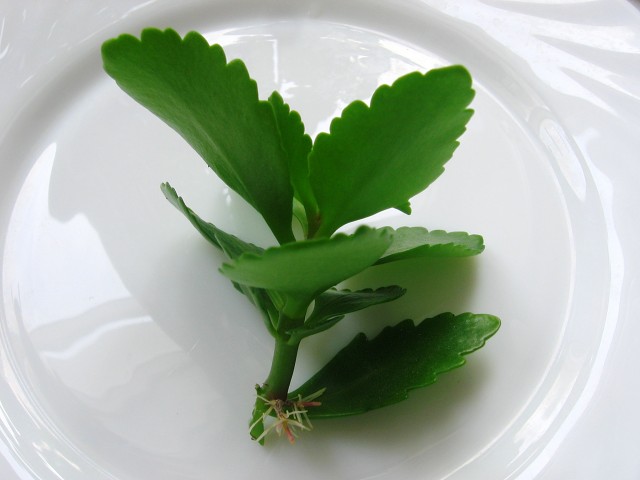
In order to make Kalanchoe bloom, it is often enough to simply replant the flower. But at home, this procedure should be done carefully if you want to achieve a positive result.
- Features of transplantation:
- the flower is picky about the soil. It does not tolerate acidic and heavy soils. You should also avoid oily soils, as in this situation the plant will definitely not bloom. It can be grown at home on soil containing equal parts of leaf turf, humus soil, and peat/sand. If possible, you can add a handful of manure or humus to the soil. But in this situation you should not be zealous. It is better to choose special soil for succulents;
transplantation is carried out annually. This should be done in March (in the first or third decade).
You need to choose a pot that is not too spacious for the plant. In this case, the presence of drainage is mandatory.
During transplantation, it is necessary to remember about hydration. The flower should grow in high humidity and moderate watering. At the same time, some experts recommend creating conditions for abundant watering in dry air.

Temperature For growing Kalanchoe, a room with a temperature range from 16 to 25 degrees is suitable. In the presence of Additional lighting may be used. For flowering in winter, the temperature can be reduced by putting the plant into a dormant state. Here the optimal temperature will be from 10 to 15 degrees. In this case, you need to reduce watering to 1 time per month. The formation of an earthen coma is even allowed. In summer, the flower can be planted in the garden. Digging is carried out only together with the pot, otherwise the plant will grow greatly.
Separately, it is worth noting that Kalanchoe has a negative attitude towards heat flows. Therefore, it cannot be left opposite open windows. You should also keep the pot away from heating appliances.
Video “Kalanchoe: so different and bizarre”
How to water
Due to the fact that the root system of the flower is prone to rotting, watering must be balanced. The soil should have time to dry out slightly between waterings. In summer you can water 2 times a week, and in autumn - once. When the plant is at rest, watering is carried out once a month. Watering Kalanchoe can only be done with settled water at room temperature.
You need to know that this plant is drought-resistant. But if there is insufficient watering, leaves may fall off. To prevent this situation, the leaves should be sprayed with water (except for varieties with velvet leaves).
What to do for flowering
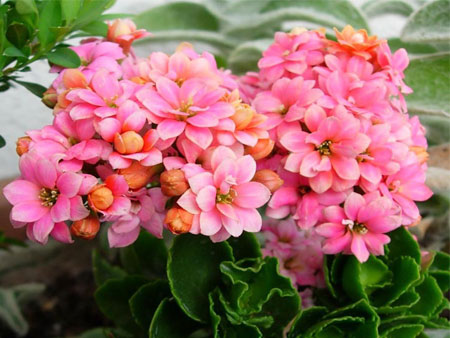
Despite everything, there are situations when a plant receives optimal care, but still does not bloom. If at home the Kalanchoe still does not bloom, then you can use some tricks. For example, you can introduce a flower into the winter. For this house you should simulate the winter period:
- reduce daylight hours to 9-10 hours;
- the rest of the time we protect the flower from light;
- the darkening lasts several months;
- we use special fertilizers;
- reduce the amount of watering to once a month.
After the simulated winter period ends, your Kalanchoe will definitely begin to bloom.
Normally, a flower can bloom from 2 weeks to 3 months. Some varieties can bloom for up to six months. If flowering is insufficient or the inflorescences are small, agronomic practices need to be changed. For example, stop feeding when the first inflorescences appear. During this period, you can apply mineral fertilizers for cacti.
Why doesn't Kalanchoe bloom, but only leaves grow? This question arises for many gardeners. When purchasing in a store, the seller assures that care is very simple. So people relax, not really caring about the plant.
Sorry, there will be no magic. Without care, only dandelions bloom. And you will have to dance around the Kalanchoe. It’s not that long, but if you want the result - lush flowering, then you’ll have to set aside some time.
What causes Kalanchoe to bloom? Just a few factors:
- temperature
- a haircut
So let's look at all the points in detail.
Lighting
Most people believe that plants need a lot of sunlight to bloom. This is true, but only partly. Kalanchoe loves bright light. But here’s the catch: the plant lays flower buds only in short daylight conditions. That is, no more than 10 hours.
How to get out of the situation? Very simple. For this you will need a dark shelter. It could be a cone made of thick paper, cardboard box or even a piece of opaque fabric. For example, black covering material. Any of the above needs to cover the Kalanchoe at 19.00, and open it in the morning at 7.00.
By the way, Kalanchoe is not afraid of direct sunlight. Therefore, it can be safely grown on southern or western windows.
On northern windows, the plant may simply not have enough lighting. The plant will begin to stretch, the leaves will shred and fall off. So you will have to get special lamps, or come up with another way out. Otherwise, instead of a fluffy flowering bush, you will get a long, skinny, bald branch.
Windows facing east would be ideal. There is enough bright light there, plus the sun goes away after lunch. This means there is no need for additional darkening.
Advice. Kalanchoe can be safely grown in the back of the room. Naturally, additional illumination lamps will have to be turned on all year round.
Watering and temperature
Failure to comply with the correct watering regime is one of the reasons for the lack of flowering of Kalanchoe. Not everyone knows that this is a succulent. And pour water as soon as it dries upper layer soil in a pot. Why should a plant strive to continue its genus with flowers and seeds if there is always enough liquid? You can safely increase the green mass.
In winter, the apartment is almost always hot and dry. Under such conditions, flower buds are not formed. You need to change the temperature policy a little in order to admire the fabulous bouquet afterwards.
Under natural conditions, Kalanchoe finds itself cool in autumn and winter, and the ground is dry. In spring and summer there are regular rains, the air is warm and humid. Therefore, when growing indoors, you should strive to create a similar microclimate. That is:
- In autumn, watering is gradually reduced. They are guided by the principle that the top layer of soil has dried out plus another 3-4 days.
- The ambient temperature is also gradually reduced, bringing it to +19-21°C.
- Sometimes the plant itself is sprayed, about once a week.
- With the arrival of spring, watering is increased, reaching the norm. But don't overdo it! Root rot will definitely not promote flowering.
- The temperature is raised to +25-27°C.
- Spraying is increased up to 3 times a week.
Thanks to these actions, the formation of flower buds will begin in the fall. And in the spring, Kalanchoe will wake up and begin to bloom actively.
And further. Provide good drainage in the container. At home, Kalanchoe is accustomed to loose rocky soil. Therefore, its roots breathe freely. And if there is a swamp in the pot, the plant will simply get sick and die. What kind of flowers are there?
Advice. Water for irrigation is settled, but not boiled. After all, boiling rain does not happen in nature.
A haircut
Very important point for flowering. The fact is that flowers grow only on the tips of young shoots. How does it usually happen? The Kalanchoe bloomed, cut it off and left it. Let it grow as it wishes. So he wants to pull a couple of long branches. There will never be flowers on them again.
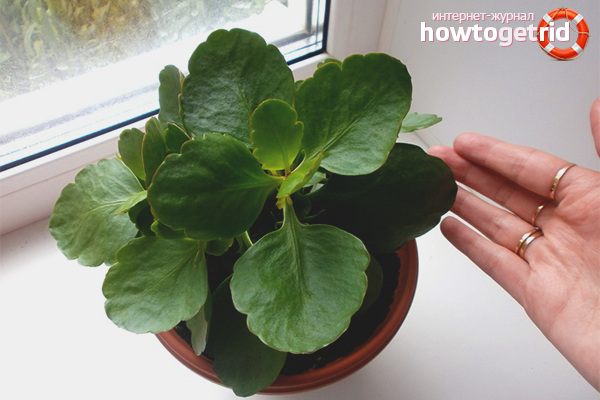
In order for the plant to set flower buds, it is necessary to provoke the formation of lateral shoots. This is most convenient to do in the summer, when branches are actively growing. All you need to do is pinch off the old tops. However, this may not be enough.
Until September you will have to regularly inspect the plant and trim it. If you leave things to chance, the bush will not be lush. It will simply continue to grow a few side branches, and by the time it blooms it will completely lose its shape.
Some gardeners don’t bother at all about pinching shoots correctly. They simply root small shoots in new soil, and throw away the old plants or leave them as a mother plant for the production of young shoots.
Advice. It is impossible to form Kalanchoe in autumn and winter. By mistake, you can cut off flower buds along with the tops of new shoots.
Other factors
We looked at the main reasons why Kalanchoe does not bloom, but only leaves grow. But besides direct ones, there may also be indirect culprits. They shouldn't be discounted either.
Feeding
Flowering always takes a lot of energy and nutrients from any plant. And if those growing in nature can easily replenish reserves from the ground, then indoor ones have to help. After all, there is no normal amount of microelements in the pot.
Any mineral fertilizer with a complex composition is suitable for feeding. It is not at all necessary to look for something special for succulents. It is enough to simply reduce the dosage of the universal composition. 2 times better.
Just don’t feed Kalanchoe too often. After all, it is accustomed to a very meager diet. Excess fertilizer can lead to the development of diseases or tissue necrosis. By the way, how many times per season to feed Kalanchoe cannot be said so simply. This should be written on the packaging. We recommend no more than once a month. In winter and autumn they do not fertilize at all. This is a time of rest and preparation for flowering, and excess nutrition will disrupt the normal cycle. Kalanchoe will grow, but will not bloom.
Pot size
Some sources recommend replanting Kalanchoe annually in a new pot. But they don't explain the reason. I wonder why the plant needs a different container each time? Nothing other than a tribute to fashion. How else to explain such regular invasion of the root system? And where will we have to wait for flowers when the plant does nothing but adapt?
There is no need to once again open the root system and replant Kalanchoe annually. This only needs to be done when the roots become really cramped in the pot. And it is advisable to carry out the entire procedure in the summer, after the end of the next flowering.
In principle, you can do a transplant in the fall, but only before the period of hibernation and the formation of flower buds begins. And they don’t choose a pot that is much larger in diameter than the previous one. In a container that is too free, the Kalanchoe will become lazy and will not bloom.
Pests
In our climate, there are no Kalanchoe lovers among insects. But the aphid does not understand which continent its “food” came from. She often enjoys the juice from the plump leaves. As a result, the plant becomes weakened and has no strength left to flower.
If March has come, and buds are not yet visible on the Kalanchoe, despite excellent conditions maintenance and proper care, then carefully examine the entire plant. You have to be a very inattentive person or completely blind not to notice uninvited guests. Moreover, appearance Kalanchoe when infected with aphids always leaves much to be desired.
If pests are detected, immediately bathe the entire plant in a solution of laundry soap. In this case, be sure to cover the soil in the pot with foil or thick polyethylene.
If the damage is severe, and this happens even to the most diligent owners, soap will not help. You will have to use insecticides. Of course, the drugs are chemical, but here you need to decide what is more important. The choice is between the terry principles of organic farming and the health (flowers) of Kalanchoe. First, save the Kalanchoe from death, and only then reproach yourself for using it industrial products. Don't forget about basic care.
Diseases
Kalanchoe practically does not suffer from anything. But sometimes it can be attacked by bacteria or fungal spores. In most cases, the plant will cope on its own if you do not disturb it. For example, excessive watering. Because the roots suffocate, the green mass weakens, and sores develop. There will be no flowering here in any case.
First you need to help the Kalanchoe recover and come to its senses, and only then wait for the buds. To do this you need:
- Treat the bush with any systemic fungicide. It will help stop the spread of the disease.
- Adjust the watering schedule, because most Kalanchoe diseases are various rots caused by excess moisture.
- Replace the contaminated soil in the pot with new one.
- Be sure to inspect the root system. If necessary, cut off the rotten roots and cauterize them with ordinary medical brilliant green.
- Once every 8 days, spray Kalanchoe with a solution of any adaptogen. This could be aloe juice, zircon, epin.
The last point is carried out until the Kalanchoe is completely cured. And they try to look after him carefully in the future, but without fanaticism. Sometimes over-grooming does more harm than good. It will be useful for the plant to take a break from the excessive love of its owners.
In general, it is very easy to find the reason why Kalanchoe does not bloom, but only leaves grow. It is enough to take a closer look at your plant and follow the care recommendations. Then you will need very little effort, and as a result, gorgeous caps of inflorescences will appear that will delight the owners for at least 5 months.
Video: proper care of Kalanchoe
To get Kalanchoe to start at home, you can organize short daylight hours for several plants in one pot at once.
For replanting Kalanchoe, both ready-made soil for succulents and soil for flowering ornamental crops with the addition of small quantity sand. If desired, you can make your own soil mixture from:
- 2 parts humus;
- 2 parts of turf land;
- 2 parts coarse sand;
- 1 part crushed charcoal;
- 1 part crushed brick chips.
To reduce the acidity of the soil, lime flour is added to it. The dormant period, when Kalanchoe does not bloom and grows upward, restoring its strength, lasts from spring to mid-autumn.
How to make Kalanchoe bloom at home?
After the inflorescences wither and until the end of August, Kalanchoe requires fertilizing, which is best done twice a month, using ready-made mixtures for succulents.
Before starting to set flower buds, it is important to reduce the amount of nitrogen in fertilizers in order to limit the growth of shoots and foliage, redirecting energy to the formation of buds.
A month after the end of flowering, Kalanchoe is pruned:
- on young bushes that have not had time to grow, pinching the most active growth points;
- on mature plants with lignified shoots, cutting them to the height required to obtain a compact crown.
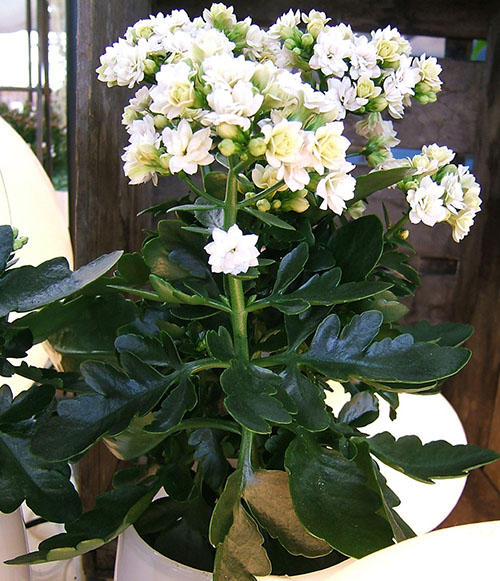 This measure will not only prevent the Kalanchoe from stretching, but also, before blooming, increase the number of shoots, on the tops of which buds are formed. The natural process of bud formation on Kalanchoe starts when daylight hours begin to decrease. In the middle zone this occurs from October to mid-March.
This measure will not only prevent the Kalanchoe from stretching, but also, before blooming, increase the number of shoots, on the tops of which buds are formed. The natural process of bud formation on Kalanchoe starts when daylight hours begin to decrease. In the middle zone this occurs from October to mid-March.
 Moreover, during the dormant period, when the plant produces new shoots, increases green mass and lays buds for future flowering, the Kalanchoe will be comfortable at a temperature:
Moreover, during the dormant period, when the plant produces new shoots, increases green mass and lays buds for future flowering, the Kalanchoe will be comfortable at a temperature:
- 18–20 °C at night;
- 22–27 °C during the day.
If the temperature drops below minimum values at night or the room becomes hotter than 24 °C, delays in the formation of buds cannot be avoided.
Drafts and exposure to cold have an extremely negative effect on the plant. Therefore, you should not place Kalanchoe, either next to heating appliances or near a window or balcony door.
Duration and intensity of lighting for Kalanchoe
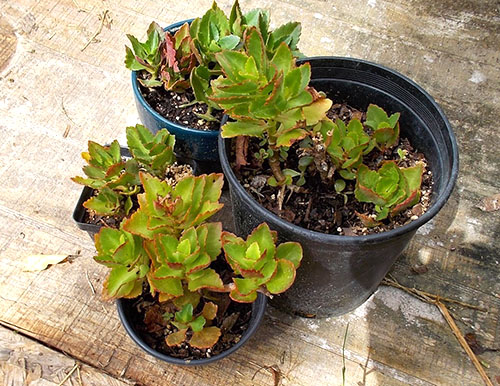 One of the most important factors in caring for Kalanchoe at home before flowering is:
One of the most important factors in caring for Kalanchoe at home before flowering is:
- During the dormant period, that is, from March to September, in the morning and afternoon hours, the plants are provided with the maximum possible lighting, and in the midday hours, when the risk of burns is high, the bushes are shaded.
- In autumn and winter there is little natural light, so shading is not required, and if the weather is cloudy or Kalanchoe is on northern windows, it is better to arrange additional lighting.
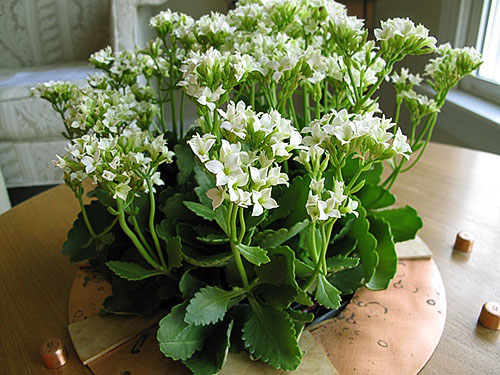 The level of illumination and comfort of Kalanchoe can be judged by the leaves and shoots of the plant:
The level of illumination and comfort of Kalanchoe can be judged by the leaves and shoots of the plant:
- With enough light, platinum sheets have a rich color, good size and healthy appearance.
- If there is not enough light, the foliage turns pale, and new stems and leaves become thinner and smaller. Old shoots stretch out, Kalanchoe does not bloom even when the duration of daylight is maintained.
- Excess light and heat energy leads to leaf burns, which look like dried whitish spots. And the growth of shoots in excessive light stops.
To program the flowering of Kalanchoe, home care must necessarily include limiting daylight hours to 8–10 hours.
If the plants are illuminated longer, the process of bud formation in autumn-winter will not start. Moreover, sources of artificial lighting must also be taken into account. Therefore, the easiest way to force Kalanchoe to bloom is to cover the plants with a cap of dark fabric in the evening and until the morning or put the pot in a closet or pantry.
Depending on the variety of Kalanchoe, the plant requires from 10 to 24 days of observing such light restrictions to set buds. If everything is done correctly, then at the beginning of winter the plants will delight you with opening buds, and flowering will last from 4 to 11 weeks.
Video about growing Kalanchoe at home
TOOLS NEEDED
PrimingWatering canKnifeScissorsSprayerPurchased soilThe soil
ExpandKalanchoe adorns the collections of many amateur gardeners. It is loved for its abundant and beautiful flowering, which can last up to 6 months a year. However, flower growers are often faced with the fact that Kalanchoe does not bloom, even with proper care and the necessary fertilizing. You must remember that everything is in your hands - a little effort and your green pet will definitely bloom.
When puzzled by the problem of why Kalanchoe does not bloom, you need to know that the plant belongs to the genus of succulent tropical plants.

Kalanchoe adorns the collections of many amateur gardeners
Therefore, in order to loving warmth, felt comfortable and willingly grew up at home, it is necessary to maintain certain conditions. Illiterate care can lead not only to a lack of flowering, but also to the death of Kalanchoe. The main mistakes florists make when caring for plants are the following:
- Unsuitable soil mixture
The most suitable soil for Kalanchoe, as for any succulents, is neutral or slightly acidic. Since the plant is a little capricious, it is better to purchase ready-made soil in a specialized store. If you want to prepare the soil at home, then experienced florists advise making the soil in the following proportions: turf soil - 4 parts, leaf soil - 2 parts and one part each of peat and sand. Mix all components thoroughly and add additional flower food.
Video about the benefits of Kalanchoe
- Insufficient lighting
When choosing a place for a pot of Kalanchoe, you should take into account that on a windowsill on the north side the plant will not receive enough light, which leads to a lack of flowering, as well as to an unpleasant modification of the leaves: the petioles are pulled out, and the shoots become more sparse. However, the flower also does not like direct sunlight, as it can lead to burns of delicate leaves. But in general, the culture loves a lot of light, and when there is a lack of it, it refuses to bloom.
- Short daylight hours
As has been noted more than once above, the homeland of Kalanchoe is the tropics. A tropical day of light lasts 12 hours, all year round. In our latitudes in winter, daylight hours are only 5-6 hours. Therefore for good growth the flower must be additionally illuminated in the autumn-winter period. At home, this can easily be done using a warm-spectrum fluorescent lamp.

For good flower growth in the autumn-winter period, it is necessary to additionally highlight
- Too much or insufficient watering
Watering Kalanchoe should be carried out taking into account the fact that succulents are desert and semi-desert plants. The flower does not need frequent and abundant watering. It is optimal to water twice a week in spring and summer, and no more than once a week in autumn and winter. But under no circumstances should you forget about watering, since in severe drought the Kalanchoe may shed its leaves. The plant should only be sprayed in hot, dry weather.
- Temperature violation.
When deciding why Kalanchoe does not bloom, be sure to remember to provide the flower with the optimal temperature for flowering. Flower buds, as a rule, form in the cold season - the optimal temperature for this process is 16-18 degrees. But at home winter season The air temperature is much higher and sometimes rises above 250C. Therefore, if possible, then from late autumn until spring it is necessary to place the plant in a cooler place - a warm loggia or a glazed balcony.
In addition to all of the above, in order for a flower to regularly delight with its blooming, it is necessary to regularly form a bush. When working with a bush, you must adhere to the following rules:
- It is necessary to remove all old peduncles. This should be done after the flowering period of Kalanchoe has ended.
- At the same time, it is necessary to trim off all excess shoots and give the bush the desired shape.
- Do not miss the moment and regularly monitor the flower, promptly removing all unnecessary shoots.

In order for a flower to regularly delight with its blooming, it is necessary to regularly form the bush
As already noted, you need to constantly monitor Kalanchoe at home. After removing old flower stalks, new shoots will appear without delay. It is necessary for them to grow a little, and then remove all the top leaves again. Young shoots will soon appear at the pinching sites, which must be pinched as soon as the third pair of leaves appears on them. The latter should take place in November. If the flower stalks have not appeared, pinching is allowed at the end of March. If all the pinching and removal of excess shoots was done in a timely manner and done correctly, then in the end you should have a beautiful and lush bush that will soon begin to form buds for flowering.
In addition, if you want the plant to bloom regularly, you need to monitor its health, and you will have to do this constantly! When the soil overflows, the flower begins to weaken and becomes susceptible to attack by powdery mildew, spider mites, gray mold and others. possible diseases. In these cases, there can be no talk of any flowering - the main thing is to try to do everything possible to resuscitate and save the plant.
Video about the conditions for caring for Kalanchoe
Shock therapy
Shock therapy is rarely used in relation to Kalanchoe, but if the flower stops blooming when all conditions are met, then the following actions should return the plant to normal. So, as a shock therapy, Kalanchoe is wrapped in a fairly thick covering material and placed in a dark place where the plant remains for three weeks without any watering. After the specified period, the pot with the flower is returned to its original place, watered and fertilized with a special fertilizer.
And finally, I would like to note that Kalanchoe, like any other plant, will definitely respond to your care and care. The main thing is not to let everything take its course, remember that at home, Kalanchoe can feel great and bloom!
November 5, 2014 / Marina Kulikova
Problems of growing Kalanchoe at home
The popularity of Kalanchoe as a houseplant is increasing every day. And there are reasons for this: long flowering, relatively small size, variety of varieties and unpretentiousness. But you may not be able to wait for the flowers to bloom again at home. Why doesn't Kalanchoe bloom?
In any flower shop and even in grocery supermarkets you can find a small one. This Blossfeld (Kalanchoe blossfeldiana), whose homeland is the mountain forests of Madagascar. It’s hard for many of us to come to terms with the fact that this is just a one-time bouquet, a gift plant, and throwing it away after flowering. Let's talk about possible and typical problems related to, and let's try to convince it to bloom again.
No re-blooming
The plants were purchased while they were in bloom; the flowering period can reach six months. But re-blooming does not occur.
Causes. To re-bloom, the plant needs a dormant period - keeping it cool and reducing the length of daylight hours.
Solution to the problem. After flowering has stopped, the plant must be pruned, removing all the inflorescences with the tips of the shoots. or on the balcony, providing shading. In early autumn, transfer to the dormant stage. For 1-2 months, the temperature should be in the range of +7...+ 12 °C, watering 3-4 days after the earthen clod dries. It is necessary to give the plant lighting no more than 8 hours a day for a month. To reduce the length of daylight hours, place the Kalanchoe in a dark place or cover it with an opaque cover from 17 to 8 hours. Even with a minor violation strict regime You can't wait for flowering. After 2 months, place the plants on the windowsill. Gradually, over the course of a week, with the help of additional lighting, you need to increase the lighting from 8 to 12 hours. Watering - as the top layer of soil dries. It is advisable to apply complex fertilizer for succulents once every 2 weeks (according to the instructions). With proper maintenance, the plant will bloom approximately 3-4 months from the beginning of the dormant period, possibly by.
Stretching of shoots and shrinking of leaves in winter
In winter, the stems of non-flowering plants become very elongated. Kalanchoe from a compact bush turns into a “giraffe” with thin, drooping shoots, pale and small leaves.
Cause. Excessive moisture and at the same time lack of natural light.
Solution to the problem. Kalanchoe is a succulent plant that requires winter watering 1-2 days after the soil has completely dried. The pot with the plant must have good drainage - at least 2 cm of expanded clay. Perlite must be added to the soil. It improves the structure of the soil, increases its aeration, and prevents putrefactive processes. In addition, perlite retains a relatively small volume of water and releases it gradually: plants need to be watered much less frequently. You can use small expanded clay. In winter, the plant should remain on the windowsill; it is useful to provide this if possible.
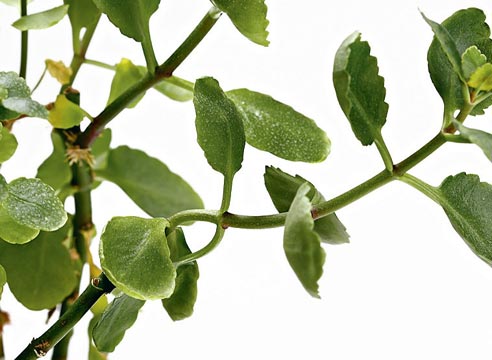
Slow development after transplantation
A plant bought in a store in bloom looks depressed and drops its leaves. Inexperienced flower growers are in a hurry to replant it in fresh soil, without waiting for the end of flowering, and do not see any improvement.
Causes. Replanting is stressful for plants, especially when energy is expended on flowering. It is strictly forbidden to replant flowering plants.
Solution to the problem. Kalanchoe can last until spring and in a leafless state, even turn green on the top. At the end of March, you need to cut off almost the entire above-ground part, leaving 1-2 buds on the shoots. New shoots will emerge from the dormant buds from the root collar. But disappointment is inevitable. Dutch houseplants Before sale, they are treated with special substances - retardants, which stop plant growth. A beautiful plant for sale: close internodes, compact growth, lush, friendly flowering. When the effect of the drug ends, Kalanchoe will produce large shoots, large leaves, ordinary flowers. You should not replant Kalanchoe until the end of flowering. At the beginning of summer, faded shoots and shoots should be pruned. Kalanchoe is undemanding to soil; it is better to use a mixture of turf and leaf soil, humus and sand in equal proportions. You can do it easier by using a ready-made mixture for succulents, adding a quarter of the humus. It should be remembered that at least 2 cm of drainage must be placed at the bottom of the pot.
Stem rot
The shoots stretch out and become thinner. The shoot begins to darken from the base. Rot rises up the stem. The plant may die.
Causes. Violation of maintenance rules, excessive watering in winter.
Solution to the problem. Cut off the tops of the shoots and root. Throw away the plant itself. Stem cuttings can be immediately planted in soil (a mixture of leaf soil and sand in equal quantities). Place the pot with the cuttings in a warm place and water it moderately, not allowing the soil to dry out. If cuttings are carried out at the beginning of summer, then if the maintenance rules are followed, the plants may bloom by winter. The survival rate of stem cuttings in Kalanchoe Blossfeld is very high. Often, at the junction of the stems, you can see young light roots forming a “skirt” in the area of the shoot node. This is a cutting almost ready for rooting. It is not without reason that the name of the genus Kalanchoe is a French phonetic transcription of the Chinese Kalan Chauhuy, which translates as “that which falls and grows.”
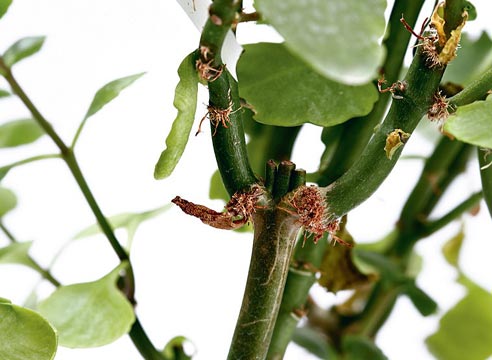
Exposure of stems
A significant part of the shoots have shed their leaves, and the stumps remaining after pruning are visible. Thin, elongated shoots grow above them.
Cause. Incorrect pruning.
Solution to the problem. When pruning Kalanchoe, the cut should be made at a height of 3-4 cm from the soil level. Then the old “stumps” will not be so noticeable after new shoots grow.
Light spots on leaves
Kalanchoe leaves are covered with light, blurry spots.
Causes. Plants are sprayed from the tap (containing magnesium and calcium salts).
Solution to the problem. Kalanchoe is a succulent plant and can easily do without spraying. But if you want to remove dust from the plant, wash it with boiled water - it has a reduced level of hardness.
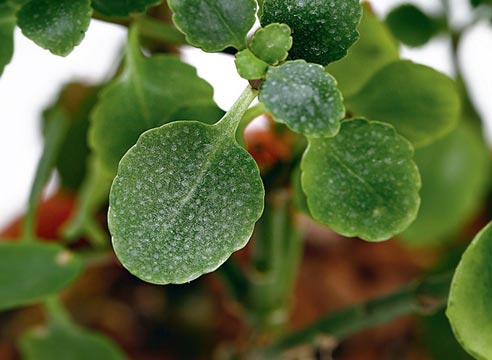
Dry brown spots on the leaves and their fall
In summer, dry brown spots appear on the leaves, after a while the leaves fall off. In this case, the stem is exposed, and the plant loses its decorative effect.
Causes. Lack of moisture.
Solution to the problem. In summer, the plant requires watering immediately after the top layer of the earthen clod dries. When watering properly, water should come out of the hole at the bottom of the pot. Only then can you be sure that the earthen ball is moistened evenly.
Drying leaves
Causes. appeared on the leaves.
Solution to the problem. Wash the plant with soapy water and take a warm shower. After a week, repeat the procedure. Ensure normal air humidity: monitor watering, spray the leaves with settled water. If necessary, treat twice with nicotine sulfate solution (3 ml per 1 liter of solution). Care should be taken when processing: work outdoors, wearing gloves. In case of severe damage, you need to remove the affected leaves and, if necessary, prune.









